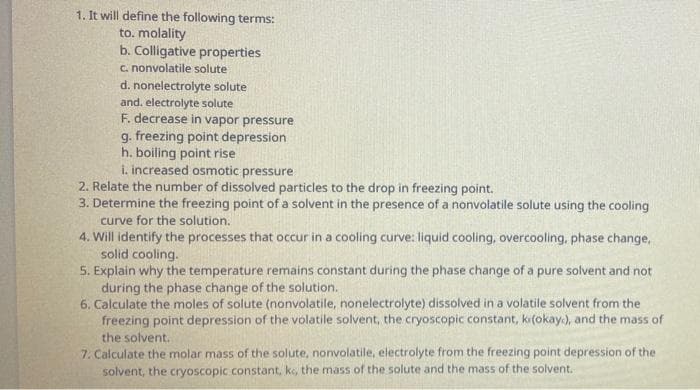1. It will define the following terms: to. molality b. Colligative properties C. nonvolatile solute d. nonelectrolyte solute and. electrolyte solute F. decrease in vapor pressure g. freezing point depression h. boiling point rise i. increased osmotic pressure 2. Relate the number of dissolved particles to the drop in freezing point.
1. It will define the following terms: to. molality b. Colligative properties C. nonvolatile solute d. nonelectrolyte solute and. electrolyte solute F. decrease in vapor pressure g. freezing point depression h. boiling point rise i. increased osmotic pressure 2. Relate the number of dissolved particles to the drop in freezing point.
Chemistry: An Atoms First Approach
2nd Edition
ISBN:9781305079243
Author:Steven S. Zumdahl, Susan A. Zumdahl
Publisher:Steven S. Zumdahl, Susan A. Zumdahl
Chapter10: Properties Of Solutions
Section: Chapter Questions
Problem 7RQ
Related questions
Question

Transcribed Image Text:1. It will define the following terms:
to. molality
b. Colligative properties
c. nonvolatile solute
d. nonelectrolyte solute
and. electrolyte solute
F. decrease in vapor pressure
g. freezing point depression
h. boiling point rise
i. increased osmotic pressure
2. Relate the number of dissolved particles to the drop in freezing point.
3. Determine the freezing point of a solvent in the presence of a nonvolatile solute using the cooling
curve for the solution.
4. Will identify the processes that occur in a cooling curve: liquid cooling, overcooling, phase change,
solid cooling.
5. Explain why the temperature remains constant during the phase change of a pure solvent and not
during the phase change of the solution.
6. Calculate the moles of solute (nonvolatile, nonelectrolyte) dissolved in a volatile solvent from the
freezing point depression of the volatile solvent, the cryoscopic constant, ki(okay), and the mass of
the solvent.
7. Calculate the molar mass of the solute, nonvolatile, electrolyte from the freezing point depression of the
solvent, the cryoscopic constant, kc, the mass of the solute and the mass of the solvent.
Expert Solution
This question has been solved!
Explore an expertly crafted, step-by-step solution for a thorough understanding of key concepts.
Step by step
Solved in 3 steps

Knowledge Booster
Learn more about
Need a deep-dive on the concept behind this application? Look no further. Learn more about this topic, chemistry and related others by exploring similar questions and additional content below.Recommended textbooks for you

Chemistry: An Atoms First Approach
Chemistry
ISBN:
9781305079243
Author:
Steven S. Zumdahl, Susan A. Zumdahl
Publisher:
Cengage Learning


Chemistry
Chemistry
ISBN:
9781305957404
Author:
Steven S. Zumdahl, Susan A. Zumdahl, Donald J. DeCoste
Publisher:
Cengage Learning

Chemistry: An Atoms First Approach
Chemistry
ISBN:
9781305079243
Author:
Steven S. Zumdahl, Susan A. Zumdahl
Publisher:
Cengage Learning


Chemistry
Chemistry
ISBN:
9781305957404
Author:
Steven S. Zumdahl, Susan A. Zumdahl, Donald J. DeCoste
Publisher:
Cengage Learning

EBK A SMALL SCALE APPROACH TO ORGANIC L
Chemistry
ISBN:
9781305446021
Author:
Lampman
Publisher:
CENGAGE LEARNING - CONSIGNMENT

Principles of Modern Chemistry
Chemistry
ISBN:
9781305079113
Author:
David W. Oxtoby, H. Pat Gillis, Laurie J. Butler
Publisher:
Cengage Learning

Chemistry: Principles and Practice
Chemistry
ISBN:
9780534420123
Author:
Daniel L. Reger, Scott R. Goode, David W. Ball, Edward Mercer
Publisher:
Cengage Learning